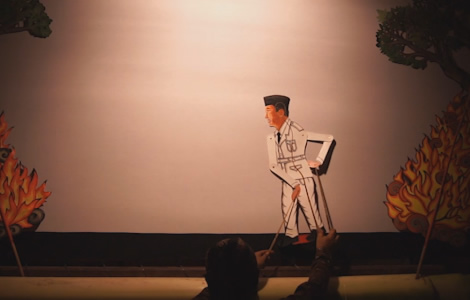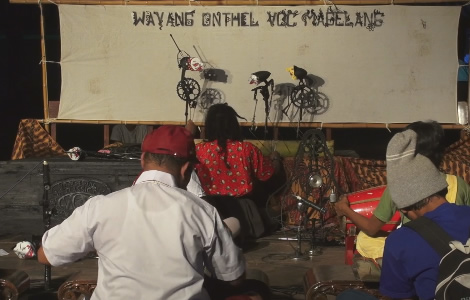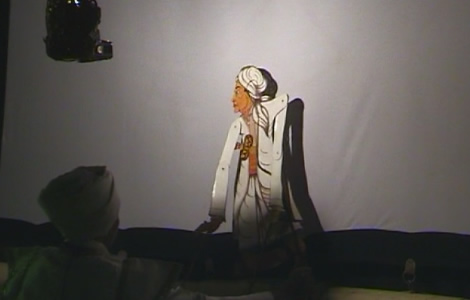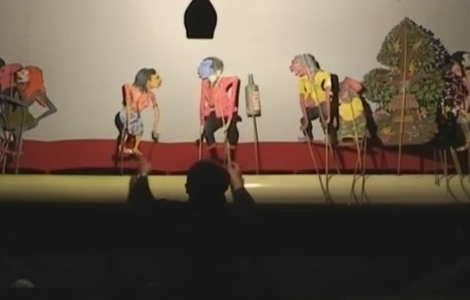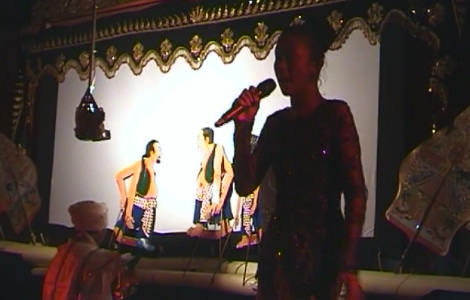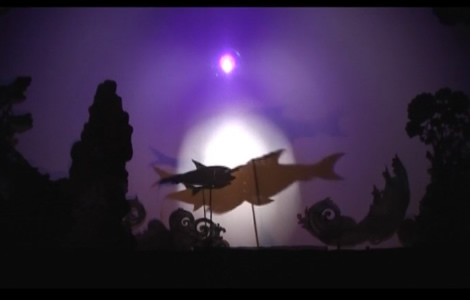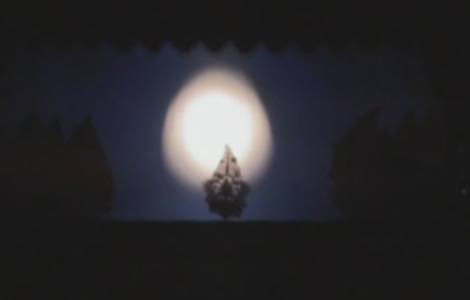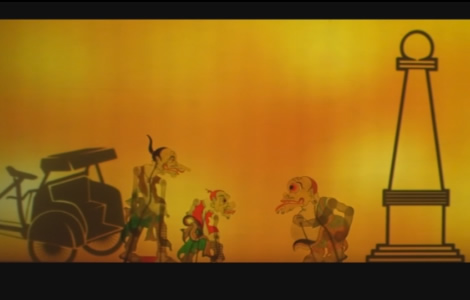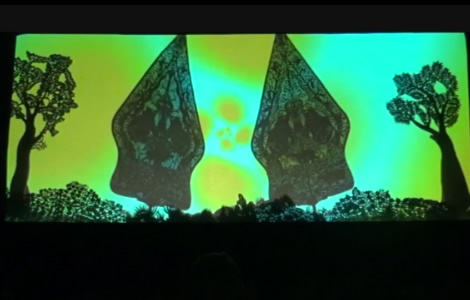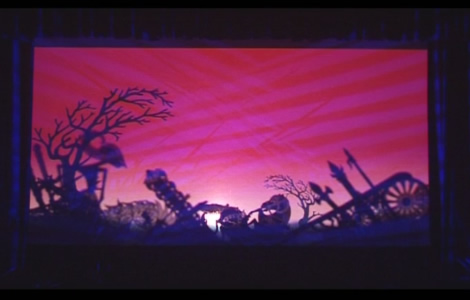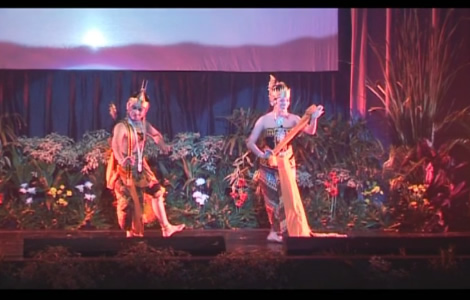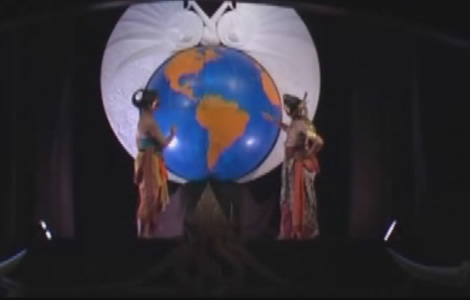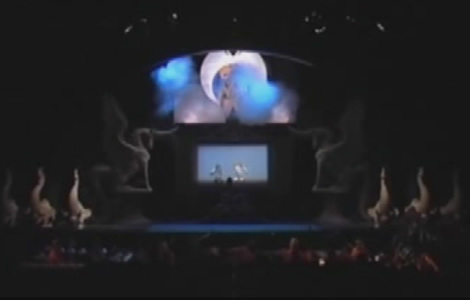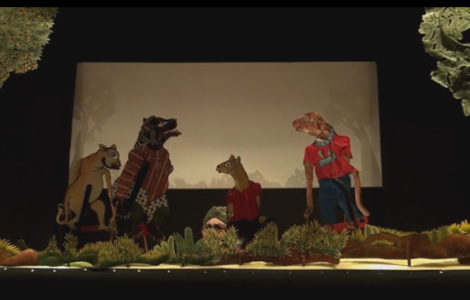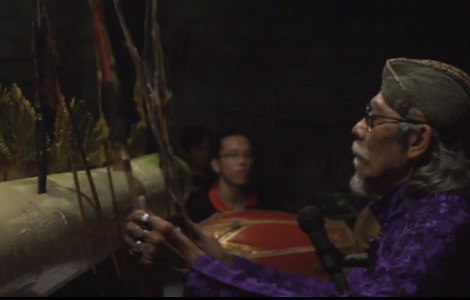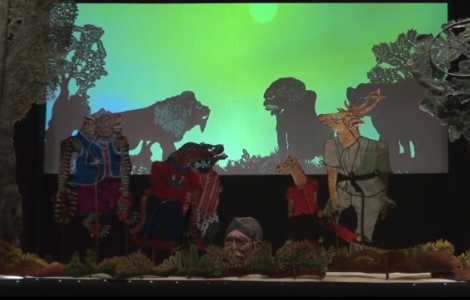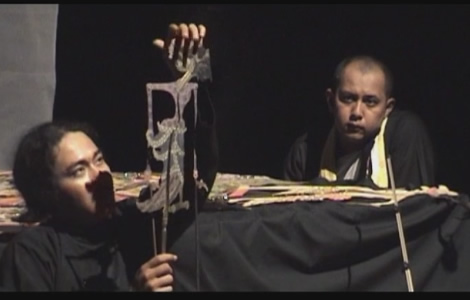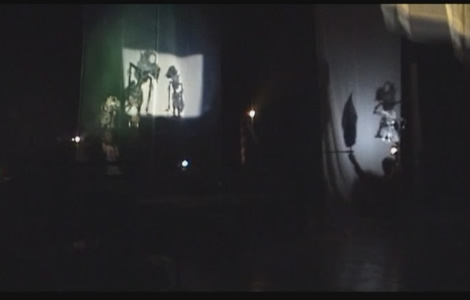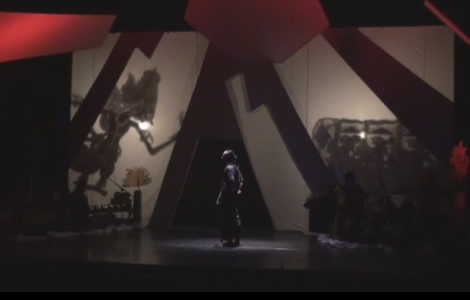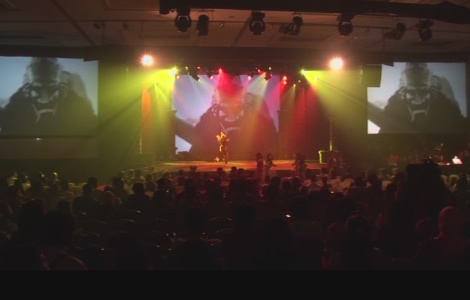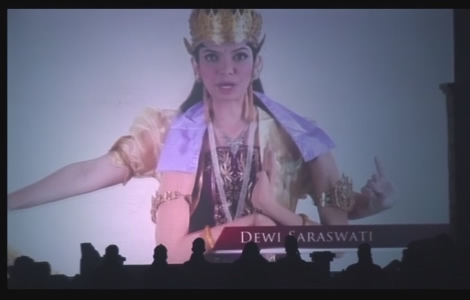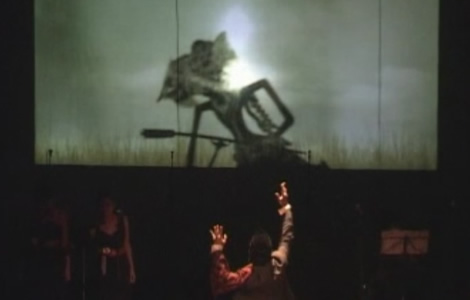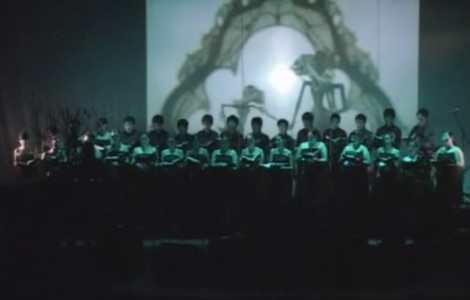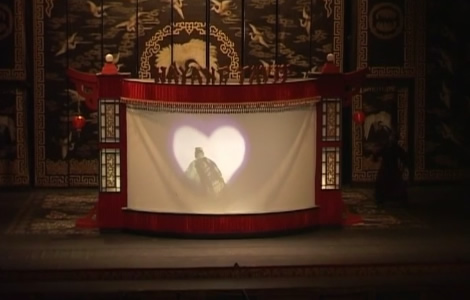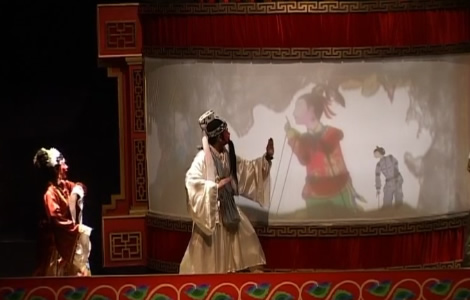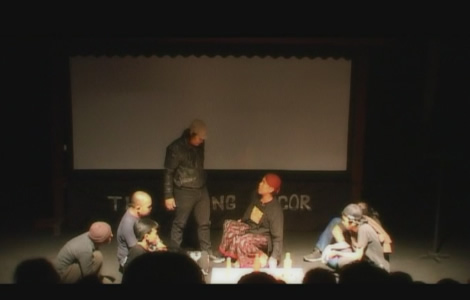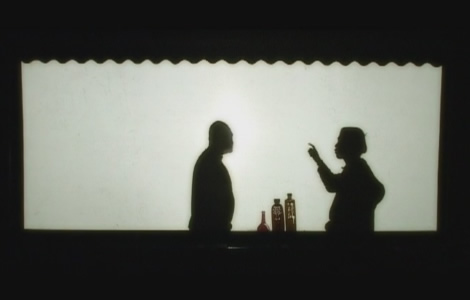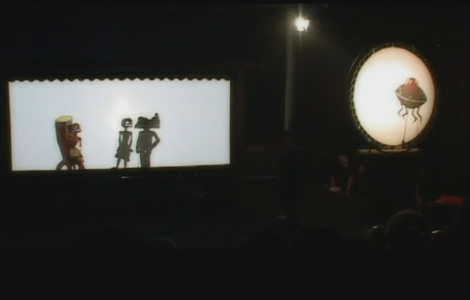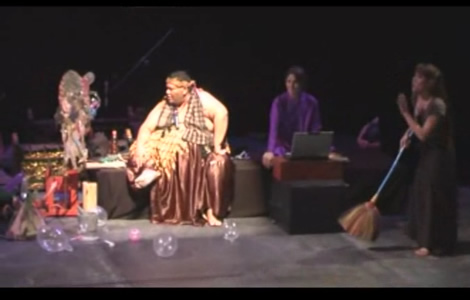0
Learning how to use space in wayang, as performer and audience, is the opposite of learning how to enjoy western theatre. In my actor training in university, I spent a considerable amount of time learning how to move around the space. Common acting exercises required the participants to develop an awareness of the space and of other people in it. In the place where I grew up, learning to be a polite spectator of drama entailed learning to keep still and be silent.
In order to create and appreciate wayang shows, I had to learn the exact opposite. As an audience member I had to learn to walk about and make loud comments to fellow spectators. As a performer, I had to learn to stay in place. A common rehearsal exercise with Pak Parjaya in Java consisted of sitting still for several hours. A dalang is supposed to remained cross-legged for seven or eight hours without interruption. As preparation for this, my teacher insisted that I remain in the appropriate sitting position for the duration of the class, which was between two and four hours. In fact, a common exercise for trainee dalang consists of sitting cross-legged in the shallow end of a river for an entire night (a practice called kungkuman), or to remain in this position for one night in a place that is famous for meditation, usually the tombstone of a famous dalang (particularly if he is your ancestor).
The dalang will not shift his position during the entire night, but the spectators are expected to wander freely around the venue of the performance. Few people watch the entire show, and those who do are hardly static. Watching different segments from different vantage points might be a strategy to induce variation and avoid boredom, and to socialize with other spectators.
The patterns of behavior outlined above might change drastically in a kontemporer performance. Sometimes, these shows require an inversion of traditional expectations of behavior that echo what happens in a western theatre play. The dalang moves around the space and interacts with other performers, while the audience is expected to remain seated and silent.
Another way to understand the usage of the space is to look at what happens on the wayang screen as a symbolic space. The following reflections are a result of my first experiences learning how to animate the puppets with my teacher and of the show I created in 2008, The Secret Life of the Volcanoes, where I used a digital projector to cast digital images on the screen. As I worked on this show, my teacher highlighted the way digital imagery problematizes traditional puppet handling conventions. I believe that many of these issues have also been encountered by the dalang kontemporer whose work I analyze later in this section.
In a conventional show, the empty space on the screen is 'manipulated' through narrative and action. Learning how to animate the puppets implies learning how to use semiotic conventions for the creation of space. Let's suppose you have a certain character, say Arjuna, who is walking through the forest. In order to represent Arjuna's journey through the forest, the puppet would enter the space from the right, walk a few steps and the disappear from the left. Then he would appear again from the right. But the space to which he now comes would be different. One can imagine this space as the continuation of the previous space. If this were a film, we could suppose that the camera has panned to the left, so now we see the space that was previously hidden. In a traditional show, this usage of the space in the empty screen requires the active imagination of the audience. Some kontemporer shows use the space in a different way, using colored lights and projections to convey specific locations in a more realistic way. The movements of the puppet which convey the journey of a character across a field or a forest are not needed in such a case, since it is the realistic imagery the one that is moved in order to generate the effect of spatial progression.
The ways in which puppets enter and exit the screen also change when digital projectors are introduced. The light bulb of traditional shows generates a light that is not uniformly distributed, but that becomes darker and blurred as it moves away from the center. Therefore, the shadows cast by the puppets are only sharp when the puppet is directly in front of the light bulb and when it is placed flush against the screen. Entrances and exits depend on this convention. When the puppet enters the space, the dalang holds it 30cm in front of the screen, either to his right or his left. Thus, the puppet casts a skewed shadow on the screen. Then the puppet is moved towards the screen, bringing the shadow into sharp focus. When the puppet exits the symbolic space in the center of the screen, the opposite effect is created. The puppet moves from a sharp focus to a blurry shadow. The light created by the projector, by contrast, is evenly distributed and the progression from blurry to sharp focus is impossible to generate with a digital projector alone.
The usage of the projector thus changes the ontology of the symbolic space, from one that is eminently an imaginative realm to a surface where realistic images are projected. This ontological change requires technical adaptations. The dalang need to find new ways to move the puppets in and out of the space. The following sections detail the way the stage and the symbolic space of the screen are used in kontemporer performances: sometimes reproducing conventional settings, sometimes substituting them for entirely new configurations and, more often than not, mixing these two possibilities.
The experience of a wayang performance is closely determined by its spatial configuration. This section analyzes what happens when this configuration is maintained. I will start by clarifying what is considered as the traditional configuration of the space in contemporary Java.
In most tradisi shows, foreign tourists arrive with their cameras and only witness the performance briefly and, most likely, from the side of the shadows. Yet, most Javanese watch the show from the side of the dalang. The foreigners might watch it from the shadow side because of the expectations they bring with them. They perhaps think this is what they are supposed to see and the fact that wayang is often described as a 'shadow theatre' does not help (in the Introduction, I suggested that it could better be described as "the art of the dalang").
The reason for the divergence in expectations and the changes in the conception of the optimal vantage point for a performance is something worth exploring. In Panji The Culture Hero, W. H. Rassers (1959) suggests that, as far as we can gather from existing records, wayang spectators have always watched the shows from both the shadow and the puppet side.
In order to support this point, he presents an overview of the writings on wayang by Raffles, Winters, Poensen, Veth and Rouffer. Rassers asserts that the missionary C. Poensen (1972) was the first person to offer a description of the arrangement of the spectators in a wayang performance venue. According to Rassers, Poensen was surprised that the women saw the shadows while the men watched the puppets. According to his informants, this situation was already old at the time and explained as an old adat (custom). G.R. Rouffer suggested that the distribution of the audience was a "corruption" of the original situation where all spectators watched the side of the shadows (qtd. in Rassers 1957: 130). Rouffer even hypothesized that this meant that the wayang was originally a performance offered for the benefit of women.
However Rassers finds Rouffer at fault and argues that this "original" situation never existed. In the earliest descriptions of wayang (written by Raffles in 1819 and Winters in 1824) there was no mention of the place of the spectators. Rassers suggests that it is possible to conclude, based on the commentary of wayang spectators of the late 19th century, that some spectators had always watched the puppets rather than the shadows and that, in fact, this was the privileged place from which to watch a performance.
The Javanese wayang is two things at once: shadow-theatre and puppet-show [...] and further, it is primarily a performance of puppets, exclusively for the tiang sepuh and the lare-lare, the adult men and the boys; they alone see what is performed in its correct relationship and in the proper grouping [...] in so far as the wayang is a shadow-play, this is a secondary phenomenon, a performance for an audience of women and children, who apparently were shown little respect (Rassers 1957: 137).
According to Rassers a long tradition of watching the wayang from the side of the shadows helps explain some puzzling facts. It is well known that in a wayang show there is a difference between the characters that enter from the left and those that enter from the right. But this refers to the left and the right of the dalang and of the spectators watching from the same side as him. The second fact is the intricacy of the carving and coloring with which the puppets are decorated.
However, this traditional setup changed in the 20th century with the introduction of raised platforms that are now ubiquitous in traditional wayang performances. In order to understand why the introduction of the platforms was deemed necessary, we need to consider some aspects of Javanese etiquette. Earlier, village dalang did not always enjoy high privilege and status and they would sit on the floor while onlookers were standing up. The spectators were looking down on the performers, which could be interpreted as offensive. The vertical hierarchy of sitting and standing positions is very important in a traditional Javanese context. If you visit someone at their home and they consider you to be of higher status, they will always sit on a surface that is at least as low as the surface on which you are sitting. This convention also governs the arrangement of the puppets in a wayang show. There are two gedebog or banana trunks in front of the screen. The upper one is reserved for characters of higher status and the opposite is true for the lower one.
Therefore, based on this perception of space, it can be said that the performers in the setting described above did not enjoy a privileged status. This is what led Nartosabdo to change the way the space in a performance was organized in the 1970s. He introduced the raised platform which is now ubiquitous in every tradisi show. Chairs and mats were provided for the spectators to look at the show from the side of the dalang. Reputedly, Ki Narto was also the first to instruct the sinden (female singers) to face the audience, and to clad the musicians of the gamelan in uniform colors. This story was told to me by Ledjar Soebroto, who worked in his early career as Nartosabdo's assistant. However, according to my teacher Sri Mulyono, the raised platform only became widely used much later, in the times when Anom Suroto became famous (the 1980s).
Wayang images from the beginning of the 20th century attest to the fact that there was no raised platform at the time. Whether the history above is the true origin of the usage of the stage or not, one thing is certain. Today, most tradisi shows in Java use a raised platform and most of the audience looks at the musicians, the singers and the dalang. From the vantage point of the majority of the spectators, the dalang can be seen selecting and animating the puppets. As described above, when the puppets enter the stage, the dalang holds them either to the left or the right of the blencong, the light hanging above his head. As they are moved from this position to the center of the screen they project a shadow that can be appreciated from either side.
Currently, there are no restrictions on who can watch the show from the side of the shadows, but few people choose to do so. In some performances, I have even seen the screen positioned flush against a wall, preventing anyone from seeing the side of the shadows. But preventing people from seeing the dalang would be unthinkable for a tradisi show. The tradisi usage of the space is not limited to the screen. During the limbukan (the scene of the female clowns Limbuk and Canggik), the dalang often interviews the sinden, asking them private questions about their lives. Although the sinden remain static during this scene, they become the focus of attention. The sinden are certainly visible throughout the night, but it is only in this scene that they become the focus of the spectators' attention and the dramatic epicenter of the performance. They are, for a moment, more like actresses than like supporting musicians. Similarly, the active space of the wayang spatial structure is also extended during the gara-gara scene. The "lens" of performative attention zooms out to include the rest of the platform. There, guest performers such as comedians and singers are often invited to participate in the performance and they generally position themselves on the same platform as the musicians.
Four of the kontemporer performances use the space in this way: Catur Kuncoro's Wayang Republik (Figure 2.31), Andri Topo's Wayang Onthel (Figure 2.32), Ananto Wicaksono's Raden Saleh (Figure 2.33) and Jlitheng Suparman's Wayang Kampung Sebelah (Figure 2.34). There are no guest performers in the first four, so the action is restricted to the screen and the shows are generally watched from the side of the performers. The recordings of the archive are therefore mostly shot from that side but include some occasional footage of the shadows for most of these shows. The exception is Wayang Onthel; on the occasion of the recording, the screen was placed next to a wall, leaving no room to record the shadows.
FIGURE 2.31. A puppet representing Sukarno in Wayang Republik.
FIGURE 2.32. The space of Wayang Onthel. The musicians occupy the platform in the way they would in a traditional show. The dalang (in a red shirt) animates the puppets made from spare bicycle parts.
FIGURE 2.33. Nanang Kancil inserts a puppet representing Raden Saleh in the gedebog in Raden Saleh.
FIGURE 2.34. Jlitheng Suparman animates two puppets placed on a gedebog in Wayang Kampung Sebelah.
Raden Saleh and Wayang Kampung Sebelah use this kind of setting but they both include guest performers. In Raden Saleh, halfway throughout the show, two songs are interpreted by musicians who place themselves in front of the platform where the rest of the musicians are located (Figure 2.35). Wayang Kampung Sebelah begins and ends with songs interpreted by a singer located in front of the musician's platform (Figure 2.36).
FIGURE 2.35. A guest singer occupies the space in front of the dalang, during a musical intermission in Raden Saleh.
FIGURE 2.36. Two guest singers perform on the platform in front of the screen in Wayang Kampung Sebelah.
All the performances in this category are seen from the side of the dalang. In a way reminiscent of traditional performances, the focus of the performance sometimes includes guest performers. The experience of these performances is preserved in the way the dalang use the space, refusing the temptation of other settings and choosing instead a conventional setup as the stage for their aesthetic innovations in language, music, story and puppets.
There are fewer performances that use traditional space settings than those that use a mixed space or a non-conventional one. Firmly rooted in conventional configurations of experience, these dalang direct their innovations in other directions and they all share certain similarities. All of them use non-conventional puppets and non-conventional stories. Of those stories, two are historical (Wayang Republik and Raden Saleh), one is an environmental parable (Wayang Onthel) and the other one is a parody of artistic institutions (>Wayang Kampung Sebelah).
Many aspects of the experience of a wayang performance are determined by its spatial configuration. This section analyzes what happens when this is reinterpreted without completely dismissing its conventions. Traditional wayang is performed within the confines of a structured spatial setup, which consists of a screen, an electric lamp, and a raised platform. Several performances refuse the temptation of spatial intermedial tradeoffs, constraining innovation to language, music, story and puppets. Those at the opposite end of the spectrum rid themselves entirely of any physical trace of the traditional wayang space. Therefore, the ones that use an intermedial space choose a more eclectic path, which can take a multiplicity of forms: the modification of the screen with the usage of colored lights or digital images, the appendage of prosceniums to wayang screens, the incorporation of several screens, or the transposition of miniature wayang devices into a different semiotic territory: that of the ‘western' theatre stage.
In the last case, the performances use the proscenium stage in a way that echoes Chiel Kattenbelt's descriptions of the usage of space in Western European intermedial theatre. Space becomes a hypermedia that stages multiple media: wayang, film and actors. Intermediality theory conceptualizes the space as the stage of intermediality (Kattenbelt 2006), in other words, it is a meta-space where all the other arts are 'staged' and their intermedial relationships are rendered visible. This explains the spatial logic of several wayang kontemporer performances, where a wayang-within-the-play is staged in a proscenium theatre.
Other performances mix the conventional paraphernalia of wayang with non-traditional protocols of spatial dramaturgy. In these performances, sometimes the action is constrained to the screen, where special effects are created by colored lights and projectors. Although using projections and colored lights on the screen might not seem remarkable to spectators unfamiliar with wayang, I argue this is an important departure from the conventions. The main space of a traditional performance is the screen. When that screen is presented in a different light (literally), it becomes an entirely different kind of space.
As mentioned in Aesthetics, Sigit Sukasman was the first person to explore the visual appearance of the screen in a contemporary way. He used colored lights on both sides of the screen. Sometimes, he directed the performers to act behind the screen and coordinated the efforts of three dalang in his shows. The combination of different dalang, performers and colored lights allowed him to explore innovative visual compositions, which can be appreciated in Sungsang Bawono Balik (Figure 2.37).
FIGURE 2.37. Two dalang, one in front and one behind the screen animate two different sets of puppets. Seroja Kusuma and Kresna (held by the dalang on the right) move out of the space, for the next scene where Limbuk and Canggik will speak. This creates a visual effects similar to a crossfade in Sungsang Bawono Balik.
The inventiveness of Sukasman's exploration of colored lights served as inspiration for Enthus Susmono. However, Enthus is the sole dalang in his shows and does not use colored compositions as extensively as Sukasman. Dewa Ruci (Figure 2.38) and Sugriwa dan Subali are examples of how Enthus uses colored lights in his shows.
FIGURE 2.38. Enthus moves two puppets representing fish while the lights change to purple and blue hues in order to represent the ocean in Dewa Ruci.
FIGURE 2.39. A golden ring encircles the kayon against a blue background. This is an example of contemporary lighting techniques used in Sugriwa dan Subali.
Other performances use video projectors in order to combine digital imagery with the shadows of wayang puppets: Wayang Mitologi(Figure 2.40), Wayang Kancil(Figure 2.41), Kalimataya (Figure 2.42) and Sumpah Pralaya (Figure 2.43).
FIGURE 2.40. The translucent puppets of Petruk, Bagong and Gareng (from left to right) are seen against a digital backdrop generated by a projector. The digital image represents a becak (traditional "bicycle taxi") on the left and the original version of the tugu (a monument in Yogyakarta that connects an imaginary line between the volcano and the kraton) on the right, in Wayang Mitologi.
FIGURE 2.41. Two kayon move towards one another against a digital animated background with yellow hues in Wayang Kancil.
FIGURE 2.42. The a battle field in Kalimataya is represented by a combination of puppets and a digital image of a red square crisscrossed by pink diagonal lines, which suggests the atmosphere of the war.
FIGURE 2.43. A wayang golek puppet and a kayon can be seen on the left, with the hand of one of the dalang sticking out of the gedebog. In the background, the shadows of two wayang kulit puppets can be seen, framed by the outline of a non-conventional kayon and abstract digital imagery generated by a projector in Sumpah Pralaya.
Sometimes, the performances also use the space in front of the screen. For example, in Wayang Hip Hop there is an acting space in front of the screen (Figure 2.44).
FIGURE 2.44. From left to right: An actor representing Mbilung and playing the guitar, the dalang, and two actors representing Bima and Gatotkaca in Wayang Hip Hop.
The possibilities explained above are not mutually exclusive. Kalimataya (Figure 2.45) and Sungsang Bawono Balik (Figure 2.46-2.48) contain scenes where dancers perform in front of the intermedial screen.
FIGURE 2.45. Two dancers perform on a platform in front of the screen in Kalimataya.
FIGURE 2.46. A performer stands in the center of the stage, in front of a screen that is framed to the left and the right by two mythological horses (Sukasman's emblem for Wayang Ukur) in Sungsang Bawono Balik.
FIGURE 2.47. To represent a voyage into the future, two performers stand on a platform above the screen in Sungsang Bawono Balik. A rotating globe is seen behind them.
FIGURE 2.48. A wide shot of the spatial set-up in Sungsang Bawono Balik. The screen is in the center, flanked by sculptures of mythological horses. Above the screen, the platform with the actors and the rotating globe can be seen.
Sumpah Pralaya(Figure 2.49) and Wayang Kancil, besides containing projections of digital images, use a second performance space placed in front of the screen: a bare banana tree trunk with no screen, reminiscent of wayang golek shows. In Wayang Kancil, each of the two dalang occupy one of the performance spaces (Figure 2.50). Nanang uses the screen and Ledjar Subroto uses the gedebog (Figure 2.51 and Figure 2.52).
FIGURE 2.49. To the right, there are two Wayang Golek (three-dimensional wooden puppets) placed on a gedebog. To the left of these puppets, seven kayon are arranged in a flower-like shape. In the background, a digital image representing architectural features is projected onto a screen.
FIGURE 2.50. Ledjar Soebroto animates four puppets that are inserted into a gedebog in Wayang Kancil. The screen, which is not used in this scene, is in the background.
FIGURE 2.51. A side shot reveals Ledjar Soebroto controlling the puppets in the anterior performance space of Wayang Kancil.
FIGURE 2.52. The two performance spaces of Wayang Kancil used simultaneously, with puppets on the anterior gedebog, and a posterior screen with digital images and puppet shadows.
Other performances take place in a 'theatrical' space. By theatrical, I mean a spatial configuration that is reminiscent of the proscenium stage which, in Indonesia is associated with teater, or western style drama. In Lara Tanpa Liru, the dalang and another actor move around the space throughout the performance. At one point, the dalang sits down holding a puppet, while he himself plays the character of Kunti (Figure 2.53). He also uses a translucent piece of fabric as a screen in several moments of the performance. Although this fabric is reminiscent of a screen, it is not used in the same way as a traditional kelir (screen) (Figure 2.54).
FIGURE 2.53. Nanang Hape (left) holding the face and the central control rod of the puppet of Kunti in Lara Tanpa Liru.
FIGURE 2.54. Two translucent fabrics in Lara Tanpa Liru. In the left one, the puppets are placed behind the screen. In the right one, the puppets are placed in front of the screen. The two spaces represent events that happen simultaneously.
Another work by Nanang Hape, Sanditama Lagu Laga, includes a play within a play, which is presented on a proscenium stage. In this show, the dalang assumes the role of director for a play in which several young people (played by actors) become the characters of the play. Sometimes the shadows of wayang puppets are projected onto a posterior screen (Figure 2.55).
FIGURE 2.55. An actor in the center of the stage faces wayang shadows, projected onto a panel to the left of the actor in Sanditama Lagu Laga.
The space of Jabang Tetuka consists of three platforms, two of which have a screen behind them. The action of the plot is sometimes presented through wayang puppets manipulated behind one of the screens, while at others it is played out by the actors or presented through video projections shown simultaneously on both screens (Figure 2.56).
FIGURE 2.56. Three screens and the performance platform in Jabang Tetuka.
At the beginning of the performance, the video projected on the screen represents a TV broadcast, where a wayang character played by an actress becomes a television presenter, reporting on the news of the wayang world which will lead to the development of the plot of Jabang Tetuka (Figure 2.57).
DEWI SARASWATI. Welcome. You are currently watching the Marcapada Newscast, with me, Dewi Saraswati. We have just received the information that the king Kalapracana has sent an envoy to ask for the hand of Dewi Supraba – the most beautiful goddess in Heaven. There is no confirmation from Heaven yet on Kalapracana's proposal to Dewi Supraba. We are still waiting for a comment from Batara Guru.
BATARA GURU. No comment. No comment. I am at the pharmacy.
DEWI SARASWATI. In the meantime, thousands of giant armed forces are on the way to Heaven, as ordered by Kalapracana.
KALAPRACANA. No comment.
DEWI SARASWATI. These is the news at Marcapada. I am Dewi Saraswati. Good bye.
FIGURE 2.57. An image of Dewi Saraswati as a television presenter is projected onto a screen in Jabang Tetuka.
In Kasmaran Tak Bertanda, there is a suspended screen, where digital images of wayang shadows are projected. Below the screen, stage front, is where most of the action takes place. Here, the dalang uses one gedebog without a screen to place the puppets. The musicians are located to his right and his left. Behind him, there is a small raised platform that is used by the chorus singers for their occasional interventions (Figure 2.58). At times, a chorus occupies the space directly in front of the screen (Figure 2.59).
FIGURE 2.58. An image of Bhisma being pierced by an arrow is projected on a screen, while Sujiwo Tejo narrates the story in Kasmaran Tak Bertanda.
FIGURE 2.59. The chorus sings against the backdrop of two wayang characters. The images of the puppets are digital projections on a screen in Kasmaran Tak Bertanda.
Teater Koma's Sie Jin Kwie Trilogy was presented on the proscenium stage of the Taman Ismail Marzuki in Jakarta. A metallic structure containing a wayang screen was wheeled in for the scenes that were narrated by dalang Tavip, and wheeled out when such scenes were over. The screen was made from a convex, white plastic surface surrounded by a decorated frame topped with the words "Wayang Tavip." This device was a self-contained performative space, fully equipped with puppets, puppeteers and light fixtures (Figure 2.60). As the structure was wheeled in and out, the usage of the space oscillated between a teater play and a wayang show. The two spaces were sometimes juxtaposed and their borders were transgressed as the dalang manipulated the actors (by changing their positions with his hands) and animated the puppets in the same scene (Figure 2.61).
FIGURE 2.60. The Wayang Tavip performance space in the center of the stage in Sie Jin Kwie.
FIGURE 2.61. Two actors interact with the puppets whose shadows are projected onto the screen inside the Tavip performance space in Sie Jin Kwie Kena Fitnah.
Eko Nugroho's Perseteruan Getah Bening starts with a scene where the dalang sets a street stall in front of a screen and tries to sell miracle cures (Figure 2.62). The action later progresses to the screen itself, first showing only the shadow of the dalang and another actor (Figure 2.63), and then displaying the colored shadows of translucent, plastic wayang puppets (Figure 2.64). The performance is divided into two sections, each with its own narrative. And they each have a different spatial logic, joined by the brief scene where an actor and the dalang interact behind the screen.
FIGURE 2.62. Seven performers in front of the screen in Perseteruan Getah Bening.
FIGURE 2.63. The dalang and an actor interact behind the screen in Perseteruan Getah Bening.
FIGURE 2.64. The shadows of the puppets projected onto a rectangular and a circular screen in Perseteruan Getah Bening.
In Eko Nugroho's Bungkusan Hati Di Dalam Kulkas there are three wayang screens of different shapes and sizes (Figure 2.65). The action transits seamlessly along these screens. When the action takes place in the left and central screens, the puppets are manipulated behind the screens and, therefore, only their colored shadows are visible. However, when the right screen is used, the puppets are manipulated in front of the screen, and both the puppets and their shadows are visible.
FIGURE 2.65. Three screens with a combination of digital images, colored lights and puppets in Bungkusan Hati di Dalam Kulkas. The screens are arranged on a proscenium stage.
This subsection has tried to answer one question: What happens when the space of wayang is reconfigured without completely dismissing its conventions? Through intermedial usages of spaces, images and lights, the dalang sometimes recreate selective aspects of a traditional wayang setup, allowing for new spatial interactions. In other cases, the dalang conspire with theatre directors to transpose those experiences into other performative realms.
Slamet Gundono was the only dalang who chose to rid himself entirely of conventional spatial markers for his performances, and this is true for all his performances considered in this dissertation: Jendral Karna, Cebolang Minggat, Wayang Tanah and Pertaruhan Drupadi. In these performances there is no visible trace of the wayang spatial paraphernalia: no blencong, screen or gedebog. In this section, I will describe the spaces of all these performances in detail. This particular category requires establishing a link with Chapter 3: Ethics, since all the performances seen here also encourage non-conventional ethical reflections.
In Pertaruhan Drupadi, there is a banana tree but it is used in the background, to stack the puppets, and not as the center of dramatic action (Figure 2.66). The usage of space in all of these performances is closely linked to contemporary proscenium stage theatrical performances (Figure 2.67). Pertaruhan Drupadi and Jendral Karna were originally recorded for a television production.
FIGURE 2.66. A kayon, Slamet Gundono and a gedebog with cooking utensils as puppets in Pertaruhan Drupadi. Abstract digital imagery is projected onto a cyclorama in the background. The shadow of the actress representing Drupadi can be seen to the dalang's left.
FIGURE 2.67. The spatial set-up of Jendral Karna. The musicians are located to the left of the dalang in a space that represents a farm. Images of clouds can be seen projected onto the cyclorama in the background.
The studio where they were recorded had a concave cyclorama in the background where colored lights and images were projected. The dalang and actors occupied most of the space in front of the screen throughout the performances. In Jendral Karna, a special effect was used to generate two images of Slamet Gundono, as he played both Karna and Arjuna in the duel where the former dies (see Puppets) (Figure 2.68).
FIGURE 2.68. Two images of Slamet Gundono in Jendral Karna. This visual effect conveys the confrontation between Karna and Arjuna.
Cebolang Minggat was presented in Jakarta, at the main stage of the Salihara cultural center. The performance includes narrated fragments, in which Slamet Gundono and Elizabeth Inandiak, sitting side by side, take turns to narrate the journey of Cebolang (Figure 2.69). During the rest of the scenes, the story is enacted by actors, including Slamet himself [see Puppets]. There are also two wayang shows during the play, in which Slamet is of course the dalang (Figure 2.70). On both occasions, the dalang uses only the puppets to represent the wayang performance, and sits in the center of the stage.
FIGURE 2.69. Slamet Gundono (left) and Elizabeth Inandiak (center), who reads words from a laptop on the proscenium stage used for Cebolang Minggat.
FIGURE 2.70. The lights highlight Slamet Gundono as he holds the puppet of Bima in Cebolang Minggat.
Wayang Tanah was performed in a very different kind of space: a cavity that was dug out of the ground (Figure 2.71). There, the dalang and the performers moved around different parts of the space, covering themselves in mud (Figure 2.72).
FIGURE 2.71. The spatial set-up of Wayang Tanah in a cavity dug in the ground. Three illuminated areas can be seen. On the left, the dalang rests on a horizontal bamboo pole. On the illuminated area on the back the musicians play their instruments. On the right, the head and part of the upper body of a dancer can be seen.
FIGURE 2.72. An agricultural ritual at the end of Wayang Tanah.
In most of the sections of this chapter, I have kept ethics and aesthetics apart. This has allowed me to argue that aesthetic innovations do not imply ethical innovation. But the performances of Slamet Gundono considered here are an exception that require a different kind of attention. By ridding himself of traditional space markers, he generated different spatial experiences that encourage critical ethical explorations. He built (literally, at times) other worlds for wayang that demand a non-conventional, critical engagement with the contemporary world of Java. By using a television set where the past and the present come together, Pertaruhan Drupadi questions the passivity of women as a desirable quality (see Women) and Jendral Karna hypothesizes that certain connections are more important than blood ties (see Familial Ties). Using a teater space, Cebolang Minggat questions the true meaning of spirituality and art (see Spirituality and Art). And a cavity dug in the soil is the stage for Wayang Tanah to begin an investigation of environmental concerns (see Environment). The traditional spatial experience is always communal and this aspect might or might not maintained in kontemporer performances.
CLOSE [X]
